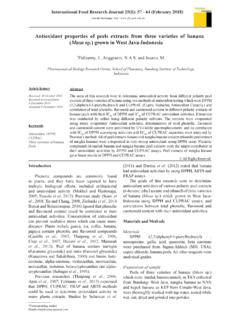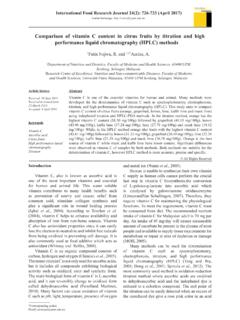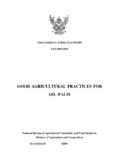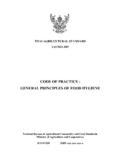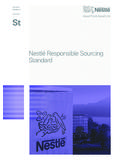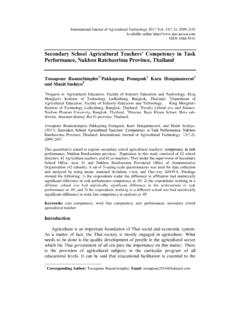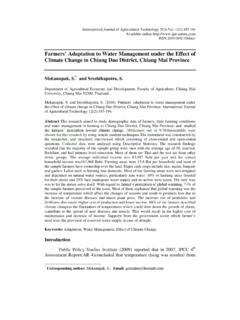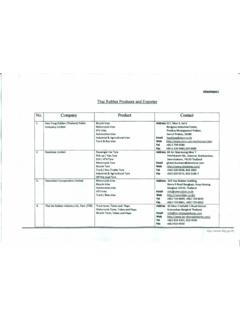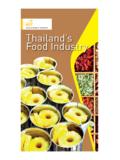Transcription of Time series analysis of factors affecting the demand …
1 All Rights Reserved*Corresponding author. Email: International Food Research Journal 22(5): 1870-1877 (2015)Journal homepage: *Chung, B. H. and Tan, J. R. Institute of Agricultural and Food Policy Studies, Universiti Putra Malaysia, 43400, UPM Serdang, Selangor, MalaysiaTime series analysis of factors affecting the demand for local rice in MalaysiaAbstractThe own price, income and price of a substitute are the determinants of demand in the classical theory of consumer behavior. We used the theory to analyze the demand for local rice in Malaysia by using time series variables. We examined whether there is a long run relationship among the variables by using the unit root and cointegration tests.
2 We then conducted the Granger causality, variance decomposition and impulse response function tests to examine their directions of causality as well as short term dynamics. The results show that there is a long run relationship among the variables and a unidirectional causality from price and income to demand . There are also lagged and short term dynamics among the variables. IntroductionRice is a staple food that provides daily caloric needs for Malaysia s 30 million people. It is also a major source of income for rural households in Malaysia, many of whom fall into a category of low income households. Policy makers are keen on maintaining rice affordable for all consumers and at the same time raising paddy farmers income.
3 Hence, the Malaysian authority has implemented protectionist policies like price controls and offered paddy farmers various types of subsidy to raise local production. However, Malaysia is a net importer of rice as local production still falls short of local consumption. About 30% of the rice demand in Malaysia is fulfilled by import. The Malaysian rice market has three grades for locally produced rice, Super Tempatan 15% (ST15), and Super Special Tempatan 5% and 10% (SST5 & SST10). The grade number indicates a proportion of broken rice in the rice composition. The Malaysian authority measures rice quality based on the proportion of broken rice.
4 Hence, local rice is considered homogenous. A relatively small portion of by-products such as broken rice, rice bran and husk is sold as animal feed, powders and biofuel. And specialty rice like Basmati is imported into Malaysia. The majority of imported rice is Thai or Vietnamese rice that directly competes with the local rice SST5. Total rice consumption has been increasing in Malaysia mainly because of population growth, although Malaysia s per capita consumption of rice has been falling. Steady growth in per capita income has caused a downward trend in per capita rice consumption as it appears to have become an inferior good in Malaysia. Food consumption has diversified towards more wheat, dairy and meat products, fruit and vegetables in Malaysia (Warr et al.)
5 , 2008). Although many researchers used wheat only as a substitute for rice in their empirical studies on rice demand in Malaysia, it can hardly be considered a suitable substitute. Rather, we believe that Thai or Vietnamese rice is a more appropriate substitute for rice, given the fact that rice is deeply attached to the Malaysian diet culture and cannot be extensively substituted by wheat and and Vietnamese rice have comparative advantages in both the quality and costs of rice production. This is why the Malaysian authority has allowed importing only the discrepancy between local production and consumption via BERNAS (the only licensed rice importer in the country) in order to stabilize rice prices (Abdullah et al.
6 , 2005). The authority also imposes price controls directly to insulate local market from being adversely affected by price volatility in the world market, and other factors that might affect local price and thus the demand for local rice. In short, we are particularly interested in a relationship between the demand for local rice and the world price of rice as a substitute of local rice, in addition to the other well-established determinants such as own-price and income. Hence, KeywordsDemand analysisMalaysiaLocal riceThai rice VECMA rticle historyReceived: 26 October 2014 Received in revised form: 28 January 2015 Accepted: 25 February 20151871 Chung, B.
7 H. and Tan, J. 22(5): 1870-1877we attempt to examine whether there is a long run relationship between the demand for local rice and its major determinants. We also examine their causal and dynamic relationships to see if there is any interdependence among the variables in the short and long run. It may provide some insights into the effectiveness of protectionist policies like price controls imposed by the Malaysian authority in the short and long run. Literature reviewPast empirical studies of rice demand in Malaysia indicated that rice was unresponsive to a change in price and income. Nik Fuad (1985) found the own price and income elasticity to be and , respectively.
8 While in the study by Baharumshah (1990), the own price and income elasticity were respectively and The price and income elasticity measured by IKDPM (2012) were and , respectively. These studies suggested that the demand for rice was price inelastic and rice is an inferior good. However, another study by Tey et al. (2008) using an Almost Ideal demand System (AIDS) model found that the income elasticity was , indicating that rice is a normal good in Malaysia. They argued that higher per capita income would lead to higher demand for rice, based on their observation that Malaysia s GDP and population have experienced steady growth, which leads to higher rice consumption as a whole.
9 Malaysia imports rice mainly from Thailand, Viet Nam and Pakistan. Specialty rice varieties such as Jasmine or Basmati are imported from Thailand and Pakistan. Tey and Radam (2011) found that the expenditure elasticity for rice import was for Vietnam, for Thailand, for Pakistan and for other countries, indicating that the expenditure for Vietnamese rice was elastic, while those for Thailand, Pakistan and others were inelastic. Tey and Radam (2011) explained that the quality of Vietnamese rice was considered inferior in local standard so that Malaysia imports Vietnamese rice when its price is low, and vice versa. The expenditure for Thai rice was inelastic because it caters for relatively wealthy households who consume superior rice.
10 Hence, Tey and Radam (2011) argued that Thai rice was less likely to affect local consumption substantially. Juthathip and Donghyun (2011) argued that government policy instruments like price controls and farm subsidies played an important role in reducing or delaying the transmission of price increases from the world market to the local market. Also, Dawe (2002) explained that the world price of rice was stabilized as a result of increases in rice export from Thailand, Viet Nam and the Philippines. Realizing the rice self-sufficiency in highly populated countries like China, India and Indonesia, helped maintain the world price of rice low. Dawe (2008) stated that the effect of price transmission had been largely suppressed, except when the local market was hit by the international food crisis in the late 2000s.





